Studium vývoje mikrostruktury jemnozrnných IF ocelí
Microstructural evolution of equal-channel angular pressed IF steel
Studium vývoje mikrostruktury jemnozrnných IF ocelí
rigorózní práce (UZNÁNO)

Zobrazit/
Trvalý odkaz
http://hdl.handle.net/20.500.11956/60409Identifikátory
SIS: 132074
Kolekce
- Kvalifikační práce [10691]
Autor
Fakulta / součást
Matematicko-fyzikální fakulta
Obor
Fyzika kondenzovaných soustav a materiálů
Katedra / ústav / klinika
Katedra fyziky kondenzovaných látek
Datum obhajoby
18. 1. 2013
Nakladatel
Univerzita Karlova, Matematicko-fyzikální fakultaJazyk
Slovenština
Známka
Uznáno
Klíčová slova (česky)
kanálové uhlové pretlačovanie, mikrotvrdosť, veľkosť zrna, mikroštruktúraKlíčová slova (anglicky)
ECAP - equal channel angular pressing, microhardness, grain size, microstructureKanálové uhlové pretláčanie (ECAP - equal channel angular pressing) patrí medzi pokrokové metódy zlepšovania mechanických vlastností materiálov. Táto práca sa zaoberá skúmaním vplyvu počtu pretláčaní cestou BC na veľkosť zrna, hustotu a typ dislokácii, vývoj mikroštruktúry a mechanické vlastnosti IF ocelí pomocou svetelnej mirkoskopie, difrakcie spätne odrazených elektrónov (EBSD), analýzy röntgenových difkračných profilov , meraním mikrotvrdosti a ťahovými deformačnými skúškami. Bolo zistené, že veľkosť zrna klesá so zvyšujúcim sa počtom pretláčaní. Súčasne mikrotvrdosť, hustota dislokácii a medza pevnosti narastá. Pozoroval sa aj vývoj mikroštruktúry so zvyšujúcim sa počtom pretláčaní, pričom sa sústredilo na tvorbu vysokouhlových hraníc.
Equal channel angular pressing (ECAP) belongs to advanced technologies for improving mechanical properties of materials. In the present work the influence of number of pressing by route BC on grain size, density and type of dislocation, evolution of microstructure and mechanical properties of IF steel has been investigated by means of optical microscopy, electron back-scattering diffraction (EBSD), diffraction profile analysis, microhardness testing and tensile deformations. It has been found, that the grain size decreasing with increasing number of passes. Simultaneously, the microhardness, density of dislocation and maximum true strength has been increased. The evolution of microstructure with increasing pressing number, particularly the forming of high-angle boundaries has been also examined.
